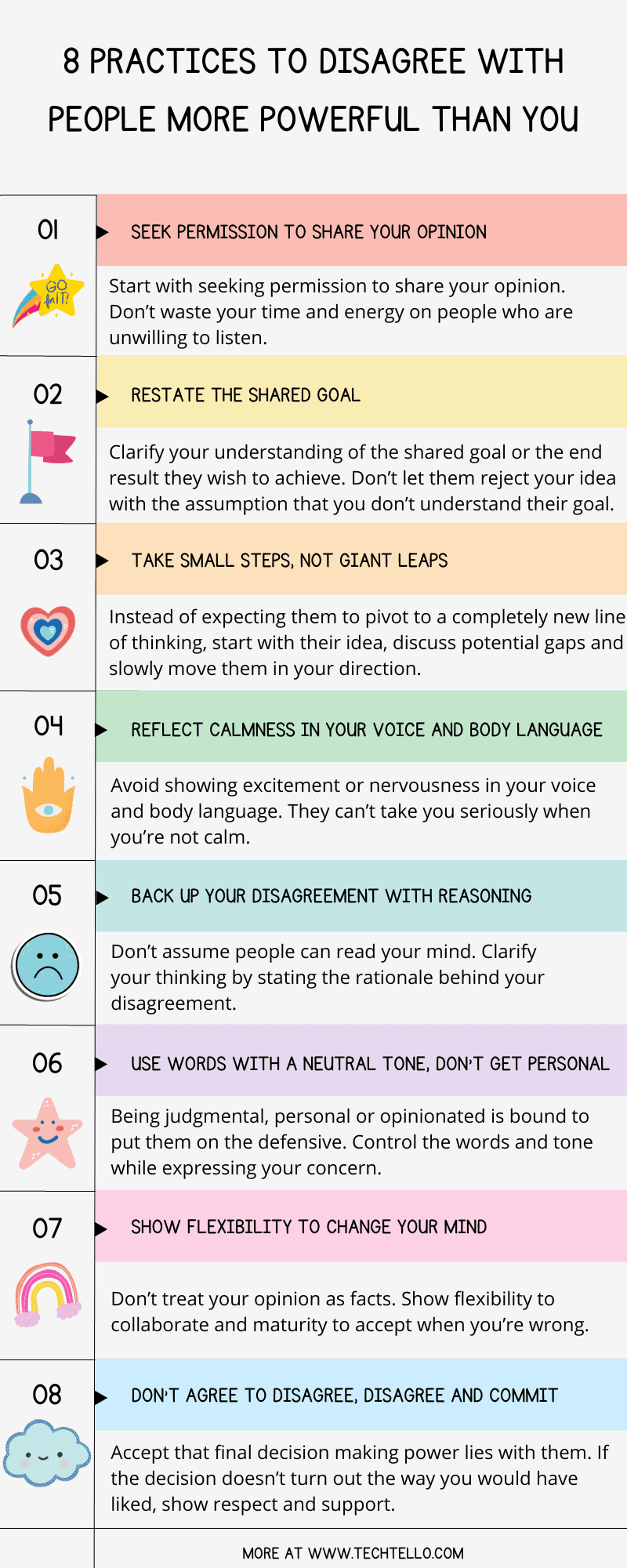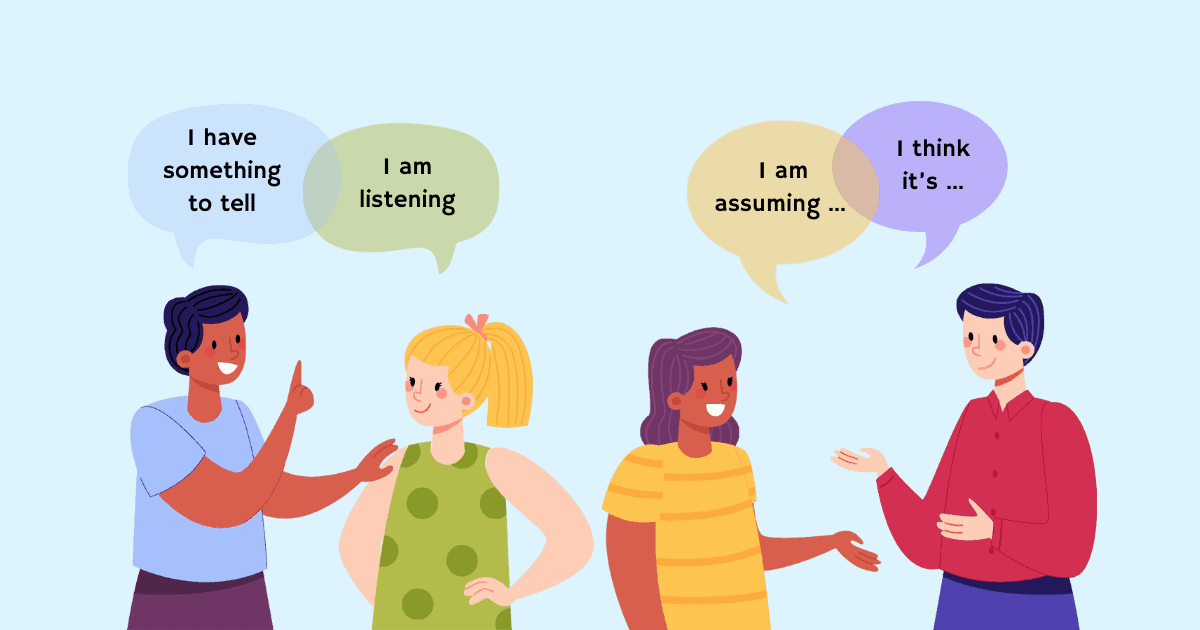How To Disagree With Someone More Powerful Than You

What do you do when you disagree with your manager or someone senior to you? Do you voice your opinion or do you choose to keep quiet?
Speaking truth to power is a rare skill. Telling someone above you that they’re wrong requires courage and confidence.
Holding your tongue and staying silent or nodding your head in agreement even when you disagree definitely feels safe. It doesn’t require fighting your fears or going against your instinct. It’s the easiest option when the idea of challenging your superior appears risky.
But not speaking your mind just because it’s uncomfortable is a costly mistake.
What if your manager commits to unrealistic timelines because they weren’t aware of the complexity involved as you chose to keep quiet?
What if a senior member of your team decides to migrate to a new tech stack which is a terrible choice because you fail to tell them how their decision could be a maintenance nightmare?
Sharing your disagreement in such moments is not only crucial, it’s a strong sign of a healthy work culture. It demonstrates your ability to think clearly, navigate complexity and solve problems. Disagreements can save time and energy by preventing critical mistakes and course correcting before it’s too late.
But sharing your disagreement with your superior is a tricky affair—you need to get their attention without being offensive.
Here are the 8 practices to disagree with people more powerful than you:
Seek permission to share your opinion
When you share your disagreement, you may have the best intentions at heart. But your intentions aren’t enough.
The person you disagree with must be willing to hear others opinions. Sharing your dissent with a person who’s unwilling to listen is frustrating and demotivating. It makes you feel small. It discourages you from speaking up again.
To gauge how the other person might react to your feedback, seek their permission. Seeking permission is also a great way to get noticed without appearing obtrusive. When they verbally commit to hearing you, they’re more likely to pay attention to what you have to say.
You can start by asking:
I share a different point of view. Would you be willing to hear it?
I have something that I would like to add to this discussion. Is it fine if I share it with you?
I want to run my thoughts through you. Can I seek your expertise on what you think about them?
Seek permission first. Get their attention. Start on the right note.
Restate the shared goal
When you speak up and share your ideas and opinions that contradict others viewpoint or how they see things, their confirmation bias kicks in. They are naturally inclined towards confirming pieces of evidence and reject anything that challenges their beliefs.
This is an unconscious thinking pattern which the brain justifies by assuming that the person sharing disagreement simply does not understand the goal.
To counter the effect of this bias, reiterate over the shared goal. Establish that you fully understand what they wish to achieve. It’s also a great way to remind them of the expected outcome when they appear to be digressing from it.
Establish shared goal by saying:
I understand that we wish to achieve [xyz].
The outcome that we all want in the end is [xyz].
Set expectations upfront that you fully understand what they wish to achieve or see as the end result. Reduce the chances of being ignored. Increase the likelihood of being heard.
Master Difficult Conversations
Engage in healthy dialogue, build stronger relationships and achieve a better outcome.
Take small steps, not giant leaps
There is a certain sense of excitement about proving others wrong. This can make you jump right into why you think something will not work or how it must be done.
But others don’t share your excitement especially when you disagree with them. This is even more crucial when you’re disagreeing with leaders or other senior people in your organization.
When you start with a radical shift in idea or an opinion that varies significantly from their current thought process, be prepared to face a lot of resistance. Their push back is justified—you haven’t pointed out the flaws in their thinking and want them to pivot to a completely new solution.
Instead of stating a completely new solution, start with their idea—explain the way you understand it, point out gaps, ask questions, seek clarity and slowly move them towards your solution.
Questioning helps people gain perspective and understand the perspectives of others. As they see issues and problems from different points of view, they gain an appreciation for their complexity—and also expand the range of possible solutions.
— Michael J. Marquardt, Leading with Questions
Take small steps by saying:
What you’ve proposed here is [this].
- How do you think it addresses [xyz]?
- How will this solve [abc]?
- What assumptions have been made?
- What if this assumption does not hold true?
- What other alternative solutions have we considered?
Start with their solution. Slowly help them see why it won’t work. Then propose a different way of doing it.
Reflect calmness in your voice and body language
When you’re excited or nervous, what you feel inside reflects in your body language.
Sharing your disagreement with someone more powerful than you is quite discomforting. Your heart may start beating faster. You may have a sick feeling in your stomach. All these and other such body sensations can lead to stress and anxiety.
Not being able to control these strong emotions can make it difficult to communicate effectively—you may start speaking faster or find it hard to put forward your thinking clearly.
When your voice and body language are not calm, it’s extremely difficult for the person you’re disagreeing with to trust your judgment.
When our body language is confident and open, other people respond in kind, unconsciously reinforcing not only their perception of us but also our perception of ourselves.
— Amy Cuddy, Presence
Before you voice your opinion, tune your mind and body to be calm and composed. Remind yourself to speak slowly. Repeat what you wish to say in your mind and then give voice to those words.
Back up your disagreement with reasoning
When you disagree with someone, there’s always a reason behind it.
Their solution has gaps.
Their assumptions are invalid.
They missed a critical edge case.
They are over simplifying something.
Illusion of transparency—a fallacy that makes you overestimate how effectively you communicate your thoughts and emotions to others—can make you assume that others can read your mind. It can make you nod your head sideways in disagreement without explicitly stating the reason behind it.
Whatever the reason, when you disagree with someone, you can’t just say “It won’t work” and expect others to assume you’re right and they’re wrong. To make your judgment credible, you have to explain the rationale behind it.
You can say things like:
I think we are missing this specific scenario. What will happen if [xyz]?
I think this assumption may not hold good because [abc].
It’s more complex than [abc] because [xyz].
Explicitly state what you want heard. Make sure others understand it the way you do. Ask questions to validate your understanding,
Use words with a neutral tone without getting personal
The biggest risk when disagreeing with people higher up in the organization is offending them. This happens when you pass personal remarks or try to prove them wrong.
This is never going to work.
You’re being short-sighted.
This is a foolish mistake.
Language like this is bound to put them off and instantly turn them against you.
When disagreeing with someone senior, you have to be super careful with the words you choose. You can’t say something and then say “I didn’t mean it that way.”
Avoid words that sound judgmental or have the potential to be misinterpreted. Don’t come across too strong. Talk about the problem without making it personal. Express your concerns in a non-judgmental neutral tone.
We cannot control the way people interpret our ideas or thoughts, but we can control the words and tones we choose to convey them. Peace is built on understanding, and wars are built on misunderstandings. Never underestimate the power of a single word, and never recklessly throw around words.
— Suzy Kassem, Rise Up and Salute the Sun
Show flexibility to change your mind, leave room for dialogue
When expressing your disagreement, becoming too attached to your point of view can prevent you from hearing others’ ideas and opinions.
You may refuse to be critiqued or state your viewpoint as a fact when it’s just an opinion. Becoming rigid in your thinking can also prevent you from thinking clearly.
When we set out to try to change someone, we are more likely to argue with and attack their story and less likely to listen. This approach increases the likelihood that they will feel defensive rather than open to learning something new. They are more likely to change if they think we understand them and if they feel heard and respected. They are more likely to change if they feel free not to.
— Douglas Stone, Difficult Conversations
When sharing your concerns with people above you, it’s crucial to make them part of the dialogue. At every stage, make them feel that they’re part of the problem solving process and their suggestions are valued.
Show flexibility by asking:
What do you think of it?
In which ways can I be wrong?
It’s my opinion. What would you suggest?
Show flexibility in your conversation. Be open to change your mind when you’re wrong. Stick to your purpose—finding the right answers, not trying to be right.
Don’t agree to disagree, disagree and commit
Finally, the decision making power lies with the person above you. All you can do is share your honest opinion and leave them to decide.
What if the decision is not inline with your expectation? What should you do then?
Instead of agree to disagree, disagree and commit. Here’s why.
Agree to disagree stems from a negative mindset that prevents you from moving forward. Depending on how strongly you view your opinion, it can make you ruminate over the decision, overthink why others cannot see your point of view and self-justify why the current decision is wrong.
Instead of accepting that it’s not about right vs wrong, you vs them, agree to disagree can make you adopt dismissive behavior and ignore the decision.
Dismissing the decision can make you non-committal and refrain from providing the necessary support to make the project successful. It can even make you secretly wish that the project fails so that you can go back and tell everyone “I told you so.”
Difference of opinion is useful to seek diverse viewpoints, evaluate solutions from different points of view and make unbiased decisions. But, when it ends with the “agree to disagree” mindset, it sabotages the purpose of a group to come together and challenge each other while remaining committed to supporting each other.
Disagree and commit divulges the importance of commitment despite our differences. At its core, it supports unity, maturity to disconnect your identity from your ideas and support others even when you do not agree with their point of view.
It doesn’t hide the fact that you disagree nor dismiss the value of your opinion, it simply guides you to know when it’s time to get past your conviction and work with others instead of working against them.
Disagreeing with people more powerful than you will not sabotage your career. It will establish you as a problem solver, a person with good ideas and ultimately build credibility. Don’t let the fear of speaking up hold you back from sharing your valuable ideas and opinions.
Summary
- Disagreeing with people above you is not easy. Fear of reprisal can make you nod in agreement even when you disagree.
- Holding back on your ideas and opinions keeps you safe, but it also means turning a blind eye to preventable mistakes.
- Practice courage and confidence to share your viewpoint without letting your fear get in the way.
- Start with seeking permission to share your opinion. Don’t waste your time and energy on people who are unwilling to listen.
- Clarify your understanding of the shared goal or the end result they wish to achieve. Don’t let them reject your idea with the assumption that you don’t understand their goal.
- Instead of expecting them to pivot to a completely new line of thinking, start with their idea, discuss potential gaps and slowly move them in the direction you want them to consider.
- Avoid showing excitement or nervousness in your voice and body language. They can’t take you seriously when you’re not calm.
- Don’t assume people can read your mind. Clarify your thinking by stating the rationale behind your disagreement.
- Being judgmental, personal or opinionated is bound to put them on the defensive. Control the words and tone while expressing your concern.
- Don’t treat your opinion as facts. Show flexibility to collaborate and maturity to accept when you’re wrong.
- Accept that final decision making power lies with them. If the decision doesn’t turn out the way you would have liked, show respect and support—don’t agree to disagree, disagree and commit.






























